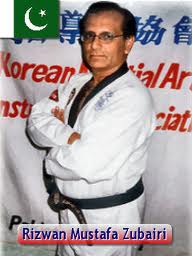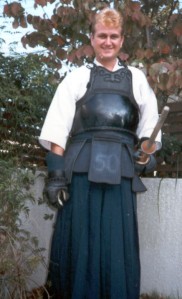I remember a discussion I had a while back with a Grand master who had returned from a Hapkido seminar that he was invited to teach. After the two day seminar was over one of the more physically fit and higher ranked men in this group of attendees confided to the Grand Master that although he had been in the martial arts for thirty years he had never even seen half of the techniques that were taught, even though many of the techniques shown were fairly basic for lower dan ranks in Korea.

Grand Master Richard Hackworth, teaches the total mind, body and spirit training that is a tradition in Korea
Unfortunately there are many in the martial arts industry who confuse gymnastics and exercise with martial arts. I am not saying that physical fitness is not important, I am saying it should not be confused with the primary mission of martial arts instruction which is self-defense training. Proper training methods help to develop your total mind, body and spirit. This particular seminar attendee obviously had trained for years while learning from a substandard instructor who camouflaged his lack of knowledge by filling the class time with exercises and repetitive drills. Those who studied with him mistook rank advancement with increasing physical fitness and speed or improvement in the limited number of techniques learned. Being able to perform a certain number of pushups was part of his black belt exam. I equate this with the man who studies for years to be the fastest draw in town without knowing you also have to put bullets in the gun, aim and fire. He may look good, be in great shape and draw first, but when he finally goes up against a real gunslinger he will learn a very nasty lesson. A teacher who would fail to seek out the advanced knowledge that he lacks while telling his students that rank requirement stuff is just “politics” is morally and ethically weak.
I recently read with great delight about Keiko Fukuda the highest-ranked female judo practitioner in history, holding the rank of 9th dan from the Kodokan and the United States Judo Federation (USJF), and 10th dan from USA Judo, and is the last surviving student of Kanō Jigorō, founder of judo. She was born in at the turn of the last century and the last video clip I saw of her when was seated in a chair with a cane teaching students at the Kodokan. Should we criticize her skills or rank because she is in her nineties and frail and not “physically fit like Heidi Klum?”
My point is that martial art rank requires not only physical skills but experience and knowledge as well. While we certainly need exercises in order to limber up and to prevent injuries, and while the more fit individual has the better chance in a physical encounter, it is not the sole factor to consider in rank advancement. In fact in the final Grand Master ranks promotion is based on education, knowledge, theory and students success rather than on a physical demonstration of fitness. My understanding is that Chuck Norris has had a hip transplant. Should we criticize his martial arts skills because he uses his son to double for his high spin kicks? Steven Segal is a little larger around the waist than he was twenty years ago. Does anyone seriously doubt his rank because he is not as fit as he once was?
While there are many tremendously fit football players in college sports, I personally would rather study with Don Shula or Dan Marino even though they may not run as fast or throw as far any more. If it is teaching I need I want the most knowledgeable instructor. Someone who has “been there done that” so to speak.
I am always impressed with men like Jack Lalaine and Buster Crabbe who could model clothes and swim the English channel in their eighties but truthfully they have always been the exception to the rule. As someone pointed out to me once, you can train a monkey to flip and kick but they can’t earn martial arts rank. Of course they can’t because there is so much more than jumping and doing cartwheels and the true masters know that. We all strive to be as fit as we can be but life and genetics take their toll.
Recently I read with horror and dismay about a sport Karate master who was sexually abusing students. Should he be praised for his fitness? Certainly not. The martial arts, especially arts like Hapkido, are also about respect, humility and self-discipline. My point is that while physical fitness is an important aspect to training it should not be confused with the end all do all of the martial arts. Again I ask you would you rather study say Kung fu with a twenty year old local tournament winner who is in perfect shape or with Jackie Chan. I know my answer but then again I am over 50 and not quite as easily impressed as I once was.
I’m sure that the master mentioned at the beginning of this article did not understand why I was not so impressed with his large biceps but lacked fundamental knowledge of Hapkido principles. He was proud of his physical strength and the hard work that it took to develop it. But he failed to realize that he had ignored the development of wisdom and virtue. It made him physically fit but morally weak and that is not the way of the Warrior.
Sponsored by www.worldmartialartsmedia.com and www.haemukwan.com



 Posted by richardhackworth
Posted by richardhackworth 





